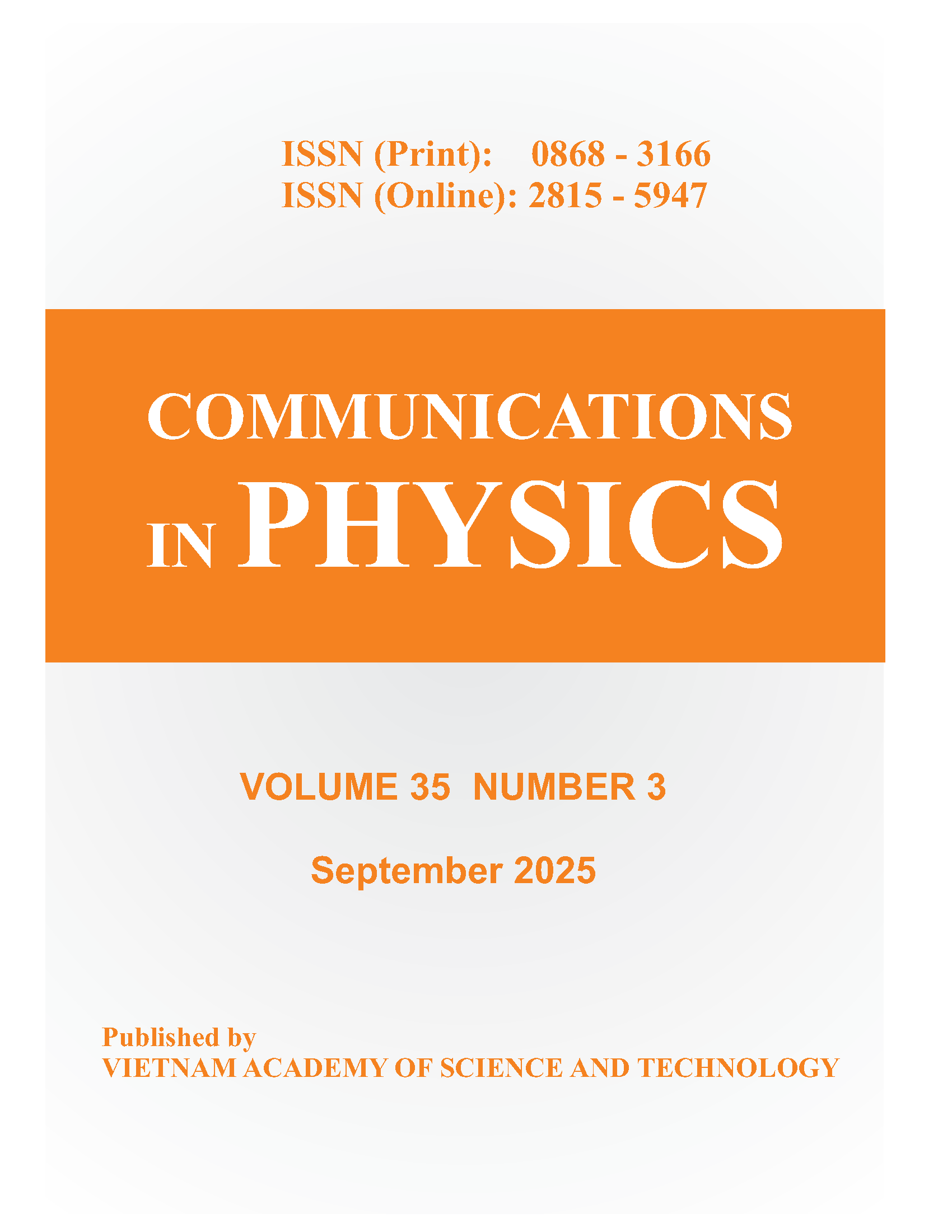Influence of Reaction Temperature on Optical Property of Mn-Doped ZnS Nanoparticles
Author affiliations
DOI:
https://doi.org/10.15625/0868-3166/23/1/2490Keywords:
Mn-doped ZnS, photoluminescence, photoluminescence excitation, absorption spectraAbstract
The reaction temperature has essential effect on quality of the product synthesized by hydrothermal method. We report here the variation of the optical characteristics of Mn-doped ZnS nanocrystallites prepared by mean of the stated method from Zn(CH$_{3}$COO)$_{2}$.2H$_{2}$O, Mn(CH$_{3}$COO)$_{2}$.4H$_{2}$O and Na$_{2}$S$_{2}$O$_{3}$.5H$_{2}$O as the precursors. The reaction temperature was set to vary from 120\r{}C to 240\r{}C at a constant reaction time of 15 hours. The XRD patterns showed that, for the reaction temperature range from 120 to 160\r{}C, the obtained products possessed a cubic $T_d^2 - F\overline 4 3m$ and a wurtzite $C_{6v}^4 - P6_3 mc$structure, in which the cubic phase was dominant. At the temperature range from 180 to 240\r{}C, the structures exhibited a cubic phase with the lattice constant increased from 5.41 to 5.43 {\AA}. The photoluminescence spectra showed that with the increase of reaction temperature from 120 to 240\r{}C the intensity of a blue band around 425 - 500 nm (attributed to both Zn, S vacancies) gradually decreased while the intensity of a yellow-orange band at 585 nm (attributed to the $^{4}$T$_{1}(^{4}$G) - $^{6}$A$_{1}(^{6}$S) transition of Mn$^{2 + }$ ions) was enhanced and reached maximum at 220\r{}C. The excitation spectra of the 585 nm band recorded at 160\r{}C showed a band at 335 nm which should be assigned to the near band-edge absorption. With increasing temperature to 200-240\r{}C the new bands appeared at 390, 430, 467, 494 nm. The intensity of these bands increased with temperature and achieved the maxima at 220\r{}C. They should be attributed to the absorption transitions of electrons from ground state $^{6}$A$_{1}(^{6}$S) to excited states$^{ 4}$E($^{4}$D); $^{4}$T$_{2}(^{4}$D); $^{4}$A$_{1}(^{4}$G) - $^{4}$E($^{4}$G); $^{4}$T$_{2}(^{4}$G) of Mn$^{2 + }$(3d$^{5})$ ions, respectively. The bands at 467, 494 nm only exposed clearly in the absorption spectra at 220\r{}C and 240\r{}C.Downloads
References
Weichen, Ramaswami Sammynaiken, Yining Huang, Jan-Olle Malm, Reine Wallenberg, Jan-Olov
Bovin, Valery Zwiller, and Nicholas A.Kotov, Journal of Applied Physics 89( 2) (2001) 1120-1129
Daisuke ADachi, Shigeki Hasui, Toshihiko Toyama, and Hiroaki Okamoto, Appl. Phys. Lett. 77(9)
(2000) 1301 -1303
Xuan Xue, Jiafu Chen, and Yong Hu, Materials Letters 61 (2007) 115-118
K. R.Murali and S.Kumaresan, Chacogenide Letters 6(1) (2009) 17-22
A. D. Dinsmore, D. S. Hsu, S. B. Qadri, J. O. Cross, T. A. Kenedy, H. F. Gray, and B. R. Ratnan,
Journal of Applied Physics 88(95) (2000) 4985-4993
Changlong Jiang, Wangqun Zhang, Guifu Zou, Weicao Yu, and Yitai Qian, Materials Chemistry and
Physics 103 (2007) 24-27
Sbiswas and Skar, Nanotechnology 19 (2008) 045710(11 pp).
Masous Salavati-Niasari, Mohammad Reza Loghman-Estarki. Fatemeh Davar, Journal of Alloys and
Compounds 475 (2009) 782-788
Li Zhang and Liangbao Yang, Cryst. Res.Technol. 43(10) (2008) 1022-1025
Weichen, Zhanguo Wang, Zhao Jun Lin Yan Xu, and Lanying Lin, J. Mater. Sci. Technol. 13 (1997)
-404
Xiaosheng Fang and Lide Zhang, J. Mater. Sci. Technol. 22(6) (2006) 721-736
Zhi Gang Chen, Jin Jou, and Dai-Wei Wng, Adv. Funt. Mater. 19 (2009) 484-490
Ying- Chun Zhu, Yoshio Bando, and Dong Feng Xue, Appl. Phys. Lett. 82(11) (2003) 1769-1771
D.Denzler, M.Olschewski and K.Sattler, J. Appl. Phys. 84(5) (1998) 2841-2845
R. N. Bhargava, D. Gallagher, X.Hong and Nurmikko, Phys. Rev. Lett. 72 (1994) 416-419
Bin Xia, I. Wuled Lenggoro, and Kikuo Okuyama, Chem. Mater. 14 (2002) 4960-4974
P. H. Borse, D. Srinivas, R. F. Shinde, S. K. Date, W. Vogel, S. K. Kulkarni, Physical Review
B60(12) (1999) 8659- 8664
M. Stefan, S. V. Nistor, D. Ghica, C. D. Mateescu, M. Nikl, and Kucerkova, Physical Review B83
(2011) 04351
Downloads
Published
How to Cite
Issue
Section
License
Communications in Physics is licensed under a Creative Commons Attribution-ShareAlike 4.0 International License.
Copyright on any research article published in Communications in Physics is retained by the respective author(s), without restrictions. Authors grant VAST Journals System (VJS) a license to publish the article and identify itself as the original publisher. Upon author(s) by giving permission to Communications in Physics either via Communications in Physics portal or other channel to publish their research work in Communications in Physics agrees to all the terms and conditions of https://creativecommons.org/licenses/by-sa/4.0/ License and terms & condition set by VJS.











